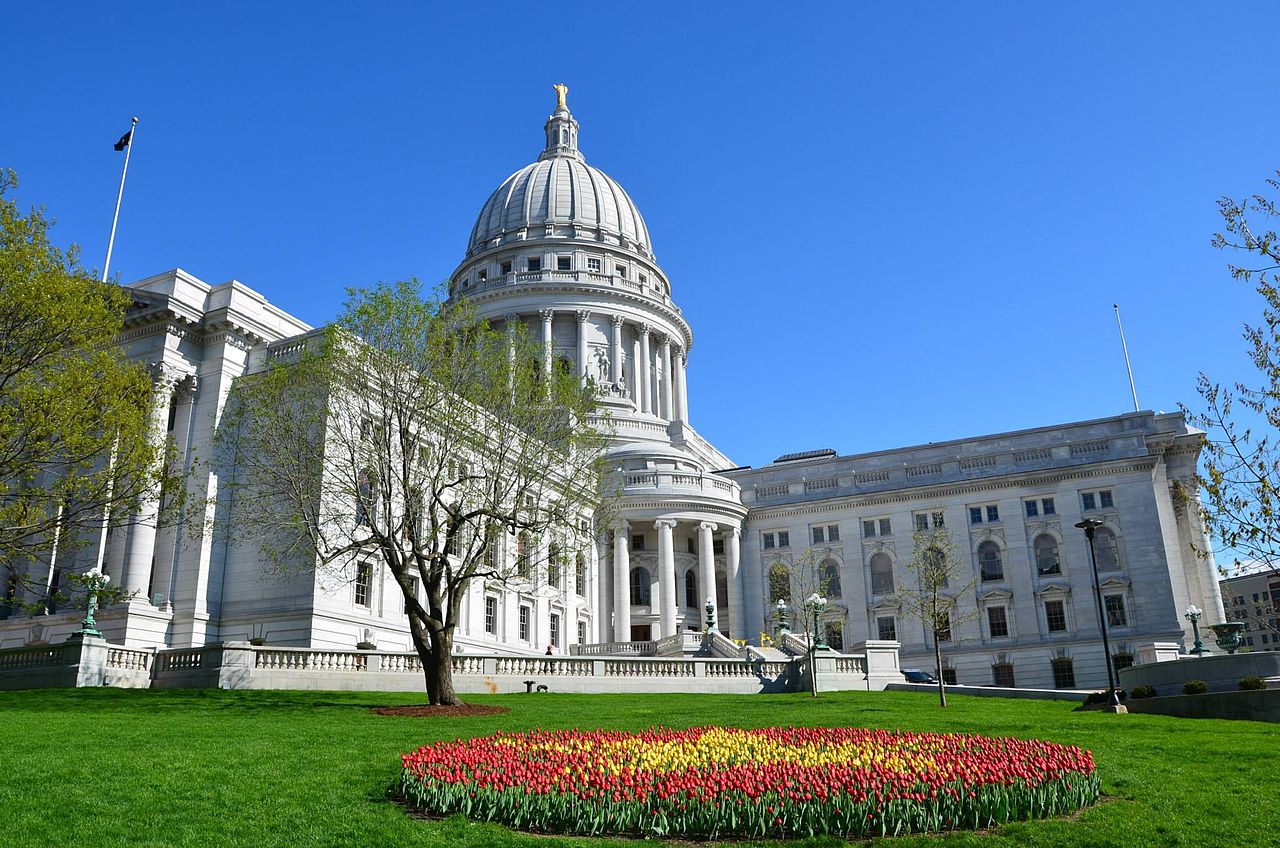Election Administration Challenges and Effects in Wisconsin
Data from Wisconsin’s primary offers room for cautious optimism heading into November. Still, reasons for concern remain.

Published by The Lawfare Institute
in Cooperation With

Lawfare is partnering with the Stanford-MIT Healthy Elections Project to produce a series on election integrity in the midst of the coronavirus crisis. The Healthy Elections Project aims to assist election officials and the public as the nation confronts the challenges that the coronavirus pandemic poses for election administration. Through student-driven research, tool development, and direct services to jurisdictions, the project focuses on confronting the logistical challenges faced by states as they make rapid transitions to mail balloting and the creation of safe polling places. Read other installments in the series here.
Wisconsin bore the brunt of conducting an election amid the coronavirus pandemic when officials decided not to delay the state’s April 7 presidential primary. Whereas most states with primaries scheduled for late March and April postponed them, Wisconsin went ahead with its elections as planned.
As the state grappled with challenges presented by the coronavirus, Lawfare published an analysis covering the multitude of legal complications and attempted legislative fixes that plagued the run-up to Wisconsin’s 2020 primary. We follow up that post with an analysis of Wisconsin’s April 7 election by the numbers, quantifying participation in the primary, the use of absentee balloting, and the causes and consequences of consolidating polling places in many of Wisconsin’s cities.
We find results that offer room for cautious optimism. Wisconsin voters shifted away from voting in person on Election Day, albeit with a substantial increase in nonreturned mail ballots. Although turnout declined from the 2016 presidential primary, the decrease can be attributed primarily to Wisconsin’s less competitive presidential primaries.
However, reasons for concern remain. Most glaringly, racial disparities occurred in the most visible strains on the system—closed polling places and nonreturned mail ballots. Wisconsin has made a concerted effort to address these issues in the ensuing primaries and upcoming general election. Whether the state’s measures will be sufficient will be evident only as the general election unfolds.
A Word About Data
This post provides analysis about voter turnout, absentee balloting, voter registration, and polling place access and effects on electoral participation in Wisconsin. The data analysis is based mostly on the Wisconsin voter registration and absentee ballot file and on Wisconsin Election Commission (WEC) turnout and registration records. The state voter file has limited demographic information. We were able to impute the race of voters using a statistical technique called Bayesian Improved Surname Geocoding. Data obtained from the voting-list company Catalist was also used in some of the analysis.
Turnout
Turnout in the Wisconsin spring election and presidential primary (both of which took place on April 7) was influenced largely by two factors.
The first was a relatively low degree of competition for the presidential primary candidates. Incumbent President Donald Trump faced scant opposition for the Republican party’s presidential nomination. And on the Democratic side, candidate Joe Biden had already largely secured his party’s nomination in the national March primaries. There was also a competitive nonpartisan state Supreme Court race between incumbent conservative Daniel Kelly and liberal challenger Jill Karofsky. But despite the state and national attention this race received, it was unable to boost turnout to levels that two competitive presidential primaries might have produced.
The second major factor was the pandemic itself. In the weeks leading up to the April primary, Wisconsin was recording between 100 and 200 new coronavirus cases per day. However, at that point, most cases were concentrated in the more urban southeastern part of Wisconsin, especially Milwaukee. A major effect of the pandemic was the closure of polling places, which decreased voter turnout.
While the more direct effects of these factors will be interpreted later on, overall turnout for the 2020 primary amounted to more than 1.5 million voters, a decrease from the 2016 turnout of more than 2.1 million voters. Both political parties experienced a decline in turnout, although Republicans saw the greater drop. Democratic turnout declined from a little over 1 million voters to just over 900,000; Republican turnout dropped from 1.1 million to 630,000. Geographically, while overall Democratic turnout declined, it increased in the counties surrounding Milwaukee and in the counties of the exurbs of the Twin Cities. The decline in Republican turnout was uniform throughout the state.
Vote Mode
The pandemic had a significant impact on the means by which voters chose to cast their ballots in Wisconsin’s 2020 primary election.
Voters in the Badger State used three modes to vote in the 2016 and 2020 primaries: in-person voting on Election Day, in-person early voting and absentee voting with mail-in ballots. On March 13, the WEC encouraged voters to switch to absentee and early voting due to coronavirus-related concerns about voting. In the end, absentee ballots rose from a mere 4 percent of all ballots cast in the 2016 primary to 59 percent—the majority voting method—in 2020. Early in-person voting doubled from 6 percent in 2016 to 12 percent in 2020, and primary Election Day voting dropped from 90 percent in 2016 to less than 29 percent in 2020.
As a result, Wisconsin’s 2020 presidential primary saw the greatest number of absentee ballots ever used in a primary or election in the state’s history—outpacing even the number of absentee ballots counted during Wisconsin’s 2016 presidential election. All age groups saw Election Day voting rates drop from around 90 percent to the low 30 percent range. Voters over the age of 60 had the lowest Election Day turnout, dropping from 84 percent in 2016 to 22 percent in 2020. And younger voters between the ages of 18 and 29 saw a drop in Election Day voting from 91 percent in 2016 to 32 percent in 2020.
But these top-level results hide important differences by race. For comparison, note that in Wisconsin’s 2016 primary, 90 percent of voters cast ballots on Election Day, and that all racial groups did so at nearly identical rates. In the state’s 2020 primary, however, in-person Election Day voting ranged from 27 percent for whites to 47 percent for Hispanics. Black voters fell in the middle, with 38 percent voting in person on Election Day. The primary beneficiary of this flight from Election Day was absentee balloting, which was used by 60 percent of white voters, 50 percent of Black voters and 45 percent of Hispanic voters.
Nonreturned Ballots
This increased reliance on mail-in voting resulted in several new complications for Wisconsin’s April election administration. One of the more prominent issues surrounding the Wisconsin primary was the return of absentee ballots. The surge in non-Election Day voting led to approximately 1.25 million unique mail ballot requests for the combination of early/absentee voting, with approximately 1.1 million ballots returned for counting. This disparity resulted in a doubling of the ballot nonreturn rate to 9.6 percent in Wisconsin’s 2020 primary, up from 5.5 percent in 2016. And differential ballot nonreturn rates between racial groups were significant—among white voters, the nonreturn rate grew from 5.2 percent in 2016 to 8.8 percent this April, while among Black voters, the nonreturn rate grew from 9.1 percent in 2016 to 17.0 percent in the 2020 Wisconsin primary.
Nearly 69,000 of the non-returned ballots in Wisconsin arrived too late to be counted this year, compared to around 10,000 in 2016. Not surprisingly, whether a ballot was returned in time to be counted (or was returned at all) depended largely on when the ballot was requested. While 92 percent of ballots requested through the end of March were counted, that figure dropped to 83 percent among ballots requested within a week of the election.
And this percentage probably would have been much lower had court decisions not allowed for more flexibility in counting late ballots. In early April, a federal appeals panel ruled that absentee ballots could be counted if they arrived within a week of the primary, so long as they were postmarked by Election Day. This resulted in an additional high estimate of 69,348 ballots being accepted for counting that otherwise would have been rejected.
The greatest discrepancies in nonreturned ballots arose among voters with previous voting history compared to those without. Among those with a prior voting history, 9.2 percent failed to return their ballots in the 2020 primary. In contrast, the nonreturn rate among first-time voters in the state’s 2020 primary was a whopping 20.7 percent.
Rejected Ballots
Even when ballots were received on time, many still weren’t counted. A total of 20,699 returned ballots were rejected for reasons other than late ballot arrival. Of these ballots, the election boards rejected 13,614 for “certification insufficient” reasons. Insufficient certification covers a large number of deficiencies such as lack of voter or witness signatures or even a missing date on the certificate itself.
Ballot rejection rates declined for every racial group except for Black voters in the 2020 Wisconsin primary. White, Hispanic, Asian and other voters all saw rejection rates drop by more than a percentage point. In contrast, the rejection rate for Black voters increased by a half percentage point.
In addition to racial disparities in ballot rejection rates for the Wisconsin primary, there were also disparities based on whether voters had prior experience. First-time voters saw their mail ballots rejected at a 2.6 percent rate, compared to 1.7 percent for experienced voters.
Polling Place Access
In an effort to address coronavirus concerns heading into the primary, Wisconsin officials drastically reduced the number of polling locations open on Election Day. The most visible polling place cuts occurred in Milwaukee, where only five polling places opened on Election Day, compared to an initially planned 180. But Milwauke wasn’t alone. A comparison of the WEC release of a report listing 2,495 planned polling places on Feb. 2 with an updated list released April 4 revealed that 387 polling locations were closed statewide, or about 15 percent of the planned total.
However, the closed polling locations were not distributed uniformly. Only 61 of the state’s 1,853 municipalities experienced polling closures. Among these, approximately 45 percent of all polling place closures took place in the city of Milwaukee. The municipalities with the next five highest numbers of poll closures were Madison (29/92), Green Bay (28/30), West Allis (13/20), Waukesha (12/13) and Kenosha (11/20).
These poll closures for both Milwaukee and the rest of the state resulted in disparate effects. The sharpest reductions in the number of polling locations tended to occur in urban areas. In fact, the median population density per square mile for closed polling places was approximately 727 people per square mile, compared to just 17 for open polling places. Only 1 percent of polling places with population densities below the median closed, compared to 31 percent with population densities above the median. And these effects extended demographically. The median population of polling places closed was 21 percent nonwhite, compared to only 4 percent for polling places that remained open. Multivariate statistical analysis showed that racial disparities persisted even when controlling for population density.
Polling Place Effects on Turnout
As Wisconsin officials struggled to conduct a safe primary election amid the pandemic, they may have created new barriers to participation in the state’s electoral process. In fact, Wisconsin offers one of the first real cases in which inadvertent voter access obstacles emerged due to coronavirus-related changes. Therefore, estimating the direct impact of how the pandemic affected participation in Wisconsin is of great importance. To address this issue, we focused our attention on Milwaukee, the county whose voting was most affected by the pandemic. We looked at both the city of Milwaukee and its surrounding suburbs.
Of Milwaukee County’s active registered voters, 42.7 percent participated in the primary. Broken down by race, 50.6 percent of registered white voters and 32.1 percent of nonwhite voters cast ballots in the April election.
Overall, 203 of the planned 260 polling places in Milwaukee County closed. Comparing where voters would have voted if all neighborhood polling places had remained open to the closest polling place that did remain open, the average voter saw his or her polling place move 2.4 miles away. (The median was 1.2 miles.) Of the voters in our sample whose nearest polling place did not close, approximately half voted. Of those whose polling places did close, 36.6 percent voted. The fall-off in participation was steeper for nonwhite voters than for whites.
Because polling places in predominantly nonwhite wards were more likely to close than those in predominantly white wards, one might imagine that the relative decline in nonwhite turnout was due to these differential closings. But that does not appear to have been the case. Even after controlling for distance to the polls, nonwhite voters turned out at a lower rate than white voters did.
Thus, while polling place closures do have a role in explaining lower nonwhite turnout in the Wisconsin primary, these closures are not the only effect and are unlikely to be the strongest statistical effect.
Conclusion
Wisconsin’s pandemic election administration offers insight into the complications that arise when a jurisdiction faces an emergency. In the state, coronavirus-related challenges have been met with an inconsistent and confusing response from political leaders and the judicial system. It is unclear whether Wisconsin’s experience can be generalized to other states, but at the very least it is a cautionary tale.
It is possible to positively interpret the overall primary turnout level, especially considering the lack of high competition for the presidential nomination in either party. However, disparities did arise, especially for new voters and racial minorities. Data from the 2020 Wisconsin primary shows that the pandemic has not affected all voters equally.
Looking ahead to November, the state has had several months to solve issues related to the pandemic as opposed to the period of a little over a month Wisconsin had to prepare for the primary. The state’s election commission has sent (or plans to send out) 2.7 million mailers to registered voters about their voting options for November. In addition, Wisconsin benefited from a $6.3 million grant program enabling the state to distribute funds to local election officials.
However, should coronavirus cases increase sharply, it is unclear if a sufficient number of poll workers will be willing to risk their health to aid in-person voting. Wisconsin already suffered a 900-person poll worker shortage several days before the Aug. 11 fall partisan primary. Given that even optimistic projections of coronavirus case rates predict a spike in the fall that exceeds that of the spring, there is reason to worry that complications with returning mail ballots, certifying returned ballots, ensuring access to polling places and tabulating mail ballots will arise in November.
Wisconsin has already made many adjustments in response to its experience conducting the presidential primary in April. But with an overburdened U.S. Postal Service and a likely spike in coronavirus cases, it is unclear whether these changes will be enough. As the state heads into the general election, the question remains: Will Wisconsin be able to administer a safe—and fair—presidential election amid the pandemic?
Postscript: Since the presidential preference primary, Wisconsin has held two additional elections that will help to inform us about its preparations for November.





